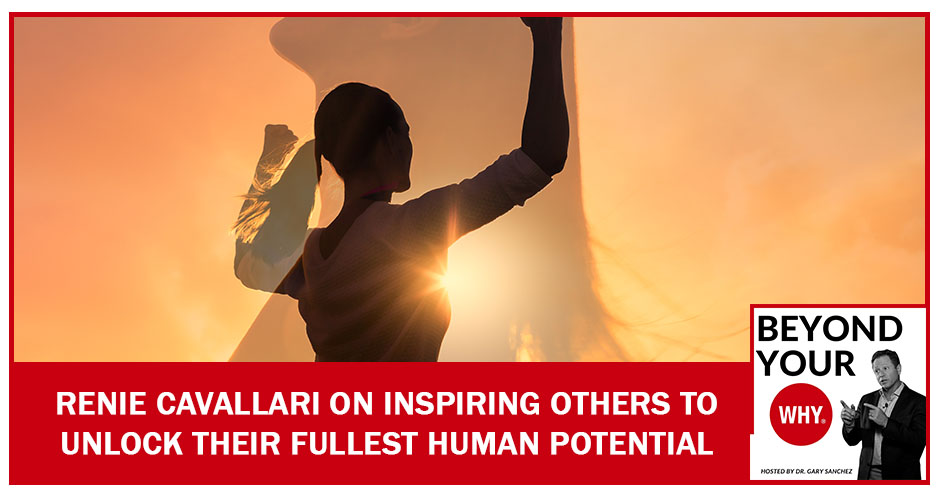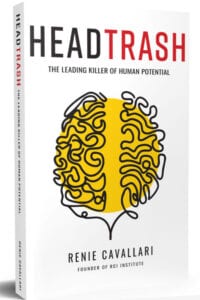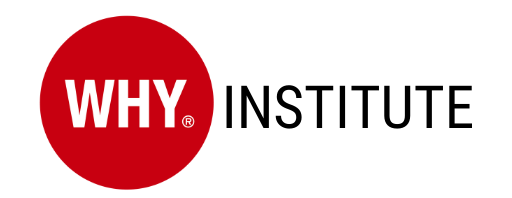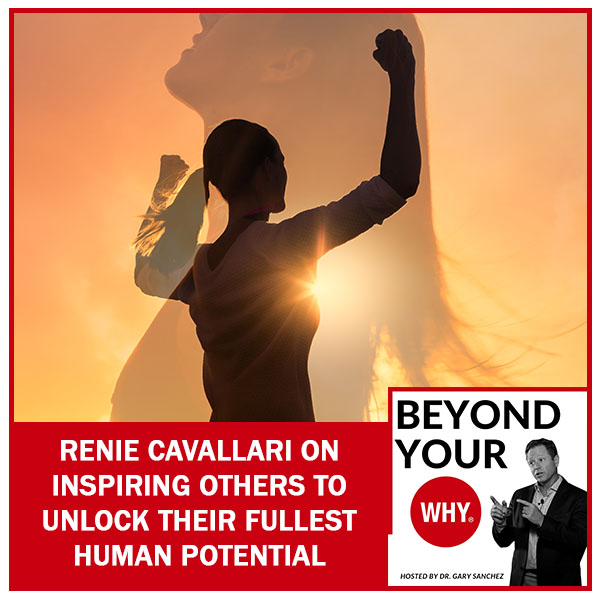
Renie Cavallari always has a lingering feeling to pursue bigger and bigger goals. This admirable thought became her drive in starting Aspire, a company focused on tapping the greatest human potential. Listen to her meaningful discussion with Dr. Gary Sanchez focused on getting rid of head trash.
She explains how freeing your mind from doubts and eliminating your big lie can lead to clarity. Discover essential advice from this conversation to start getting out of the feeling of being stuck and determine the right motivation you need. As a result, you can shift your mindset and reconnect with your emotional side that dictates your life purpose.
—
Watch the episode here:
Listen to the podcast here:
Renie Cavallari On Inspiring Others To Unlock Their Fullest Human Potential
If you’re a regular reader, you know that every week, we talk about one of the nine whys and then we bring on somebody with that why so we can see how their why has played out in their life. In this episode, we’re going to be talking about the why of a better way. If this is your why, then you are the ultimate innovator. You are constantly seeking better ways to do everything. You find yourself wanting to improve virtually anything by finding a way to make it better. You also desire to share your improvements with the world.
You constantly ask yourself questions like, “What if we tried this differently? What if we did this another way? How can we make this better?” You contribute to the world with better processes and systems while operating under the motto, “I’m often pleased, but never satisfied.” You are excellent at associating, which means that you’re adept at taking ideas or systems from one industry or discipline and applying them to another, always with the ultimate goal of improving something.
I’ve got a great guest for you. Her name is Renie Cavallari. She is the Founder, CEO and Chief Instigator of Aspire, a global transformational training and culture development company that specializes in inspired learning that shifts human behavior and awakens potential. She is also the founder of the RCI Institute, active thinking and people technology lab. An award-winning international strategist, speaker and leadership expert with a vast grasp of business and its challenges, she has driven measurable results for businesses with her innovative solutions around the world for over many years. Renie, welcome to the show.
It’s great to be here, Gary. Thank you so much.
Renie, what city are you in?
I’m in Phoenix, Arizona.
[bctt tweet=”When you’re living in your potential, you’re living in joy.” username=”whyinstitute”]
Bring us up to speed on you. Where did you grow up? Where did you go to school? How did you get into being a strategist, author and speaker? Tell us your story.
I grew up in Philly. I’m a scrappy kid from Philly. My parents were both teachers. I went to college at FSU. I got lucky and joined Corporate America right out of college. I had amazing mentors and people helping me learn and grow. I started in sales and was honestly endlessly curious all the time. Eventually, I had several great opportunities in the hospitality industry, working for various companies. I started a company called Powered by Aspire. We do transformational work. We’re about awakening the potential of people. When you talk about understanding your why, I knew what I was supposed to be doing. I wasn’t aware of it early on, but many years ago, I got very clear. That clarity has been such a gift. I’m also a mama. I have a daughter. I’m married. Also, in that beautiful transaction, I got another daughter, Alison and her husband, Greg. I have a grandson too, Aiden.
Take us back. What was that moment that you realized, “I got to go start this Powered by Aspire?” What happened? What were you doing? What were you thinking? What was going on? How did you come up with that?
I was in a fancy corporate job. I was SVP of a medium-sized, good-sized company. The partners offered me a partnership and to become the COO as well. I remember I kept thinking, “I should feel so happy about this.” I was certainly grateful for the opportunity, but I wasn’t happy. I asked for the weekend and I stopped and sat with it. I came in on Monday morning. I said, “Thank you very much. I quit.” It was about that I became aware that I wasn’t aspiring and hence the name of the company, to what I loved to do. I was doing what was next in the chain of tradition of, “You go from here to here. You’re going to be COO. Isn’t that fabulous? Next, you’ll be that.” All of a sudden, it made me awake.
I didn’t have a plan, which is crazy because I have been a strategist and strategists tend to overplan everything. I sat back and I was having dinner with a girlfriend. She said, “You should start your own firm.” I had thought that I wanted to start a firm before, but not with this. It was a crazy, snap-on tool for a diaper delivery business. What happened is that my girlfriend, Brenda Exline, had a successful ad agency. She said, “If you’re too afraid to do it, I’ll be your partner.” It was the greatest thing anyone could say because I thought, “I don’t need a partner. If she believes in me, I should go do this.”
You said you weren’t happy. Why were you not happy?

I didn’t like operating the business. I didn’t like the work because, in the operation, I wasn’t connected to my why, which was about awakening people. When you’re awakening people, it does tie to finding a better way like, “How do you keep improving?” Giving people the opening to find what they want next to live to their potential. When you’re living in your potential, you’re living in joy. That’s it. To me, success equals joy. That’s my success meter. I knew like, “I don’t like this work.” That opportunity woke me up to, “If you don’t like what you’re doing, no wonder you’re starting to get grumpy.” Things started to irritate me too much and that wasn’t my nature. It was a fantastic learning moment. When I find myself in that same place because it does come up throughout your life where you’re looking around going, “I am not my happy space.” For me, that’s the moment where I can change my thinking and think about, “What is it that I want?” versus “What is it I am doing?”
I’m sure there are going to be a lot of people that are reading this that may be in that not-so-happy place and don’t know how to put their finger on exactly what it is they’re not happy with. They just know they’re not happy. They don’t like what they’re doing, but they’re doing it because they got to make a paycheck. You were fortunate it sounds like at a young age to be able to make that transition. How did you determine what you were then going to do? Now, you’re making snap-on tools for baby diapers. How did you decide, “I think I’m going to go start Powered by Aspire?” How does that happen?
I never did that business of the snap-on tool concept where you deliver diapers. It was a concept that never got off the ground, but that was the first entrepreneurial moment for me. Because I knew what I loved to do, I was clear on that and I thought, “I’m going to start a business.” I didn’t have any people in my life that were entrepreneurs. My father was a teacher. My mother was a teacher’s assistant. There wasn’t a map of that, but I just knew like, “If I do what I love, the odds are, I should be pretty good at it.” I put it out there and started thinking about it.
I got a phone from someone who I had worked with for years. It was the greatest gift because there’s nothing like mentors and people that you imprint on that you don’t realize that you’ve done something and imprinted on them and they’re giving back to you. His name is Paul Margetson. He called me up and said, “Renie, what is your financial nut?” I was like, “I’m sorry. What?” It was a personal question. It wasn’t like he was a good friend. He was a business associate. I told him the number and it wasn’t much. I was single. It wasn’t like I had made this big decision. The company came back to me that I have resigned from and said, “We need nine months.” I had time to formulate.
That’s important for people to understand. When you want to make a shift, you don’t have to make it in a nanosecond. You start to think and explore like, “What do I love? Who can I connect with? How can I leverage that?” You certainly have done that in the chapters of your life. It starts to move because you gain clarity of it. Paul called me up and said, “I’m going to hire you. You just told me your nut.” I gave him my nut for the month. He said, “I’m going to pay you. I want you to send me a proposal of what I’m going to pay you for.” It was such a gift in so many ways because the financial freedom became clear and it wasn’t a big nut.
On the other hand, it was this opportunity he gave me to create the kind of firm I would want to work for. From that, I said, “We’re going to work on, ‘How do we transform people so that we shift their behaviors so they can perform at higher levels? When they perform at higher levels, not only do they feel better and continue to grow, but their organizations continue to perform.'” Aspire has a 96% retention of our clients year-over-year. That’s at the foundation of it when there is performance because it’s not fluffy stuff working in culture and leadership. For some people, it might be, but in our firm, it’s certainly not. It’s about this higher level and there’s nothing that turns me on more than that, like watching people soar. I’ll drink that Kool-Aid every day.
[bctt tweet=”When you want to make a shift, you don’t have to make it in a nanosecond. Always take time to think about it.” username=”whyinstitute”]
You started Powered by Aspire. What was your vision for it? I’m not sure exactly what is Powered by Aspire. Tell us what that is.
Its why is to awaken human potential. It has been that for many years. We are a transformational company. We work on transforming and performance improvement. We do training, leadership development and a lot of cultural alignment so that when you understand the company why, how and what, that alignment allows for trajectory. We work on those solutions for our clients. As their strategies change, we custom-build training so that they can bring their people along in the changes that are occurring. That’s what Aspire does. We have quite a bit of IP, intellectual property. These proven processes are focused on what we call People Technology™. These tools allow people to understand where their performance is, how to grow, what kind of mindset is going to take them to where they want to go and what skills they need. There’s a whole variety of tools in our People Technology™ war chest.
So that when they perform at a higher level, then they experience more joy?
They sure do. They stick with you as they grow in their career and the companies that they work for. There’s a beautiful synergy amongst it all. I feel so grateful that I do work where the intimacy of the relationships becomes the best value there is. I do need to be paid and the intimacy of the relationships is at the heart of our business.
It sounds like you enjoy showing people a better way to live a more inspired life.

When my team read it, there was a lot of laughter. That was autobiographical. I couldn’t have written it for myself as well as it was written, including the not-so-beautiful parts, which were so delicately put. My team might have been a little more direct on that part, that constant and never-ending improvement.
I know what it’s like because I live in that same world. We can’t turn it off. It’s just the way it is. You go to bed thinking about better ways. You wake up thinking about better ways. You didn’t choose it. It’s just how we function, but it does have its pluses. You’ve written six books. Your latest book is called what?
HEADTRASH: The Leading Killer of Human Potential.
Tell us about that. It’s a better way for what?
When we understand what our head trash is and learn how to shift our head trash get out of our head trash, then all of a sudden, we can turn on our performance, happiness and everything. Head trash is a look at what’s going on in that brain of ours. We have this physical brain that we’re all aware of that’s functional and we have an emotional brain that is all about feelings and thoughts. The emotional brain we don’t talk a lot about. We talk about mindset, but the emotional brain is more complex than just, “I should be positive.”
We need to understand that there are two sides to that emotional brain. When we get that, there are two sides, the disconnected side of the emotional brain, which is where negativity, fear, anxiety, worry and concern live. It’s all those difficult negative emotions. Also, that has physical implications too, like shortness of breath. Our body can become distressed on that side of our emotional brain. The goal of life is to get over to the connected side of your emotional brain. The more time you spend on the connected side, then the more creativity you have, collaboration, happiness, joy. You’re in gratitude and appreciation when you’re over on that side and that opens up your world. When we understand how to dump our head trash, then we change anything we want because we have clarity. When you’re up late, you can’t fall asleep, that tape is going and the nasty voices are on you, it’s hard to gain clarity in a way that’s productive.
[bctt tweet=”The more time you spend on your connected side, the more creativity, collaboration, and happiness you have.” username=”whyinstitute”]
How do you define head trash?
Head trash are the little voices in your head that are undermining you in any way they can. They’re that self-talk that gets turned on and it’s a loop usually. It can come from things like the imprints of your past. It can come from experiences that you have with someone. Clearly, your head trash is about your thoughts. We feel the way we think. A lot of times, we’re trying to change how we feel. That’s why if we just take a drug, we can change how we feel, but it’s not getting at the core. When we change how we think, that changes how we feel. How we feel ultimately determines how we’re going to behave and what action we’re going to take. If we feel crappy and we take action, it’s usually not our best self, or I’ll at least speak for myself.
When you become more aware of it, then you can stop yourself and start to say, “How do I shift out of this?” That’s what the book focuses on. It focuses on that we all have head trash and the understanding of it and then the model of, “Own it. Shift it. Dump it.” How do you do that so that you have more joy in your life? The less head trash you have, the more space for the things that you love and want. Even your aspirations and the things that you might be frustrated by because you don’t have them, you have the space to go after them versus feel crappy and therefore, you’re stuck.
What motivated you to write a book about head trash?
First of all, I consider myself an expert on head trash. I am up there. People ask me my expertise, “How long have you been a strategist? What’s your most successful strategy?” All this other kind of baloney. “What am I an expert at?” “I can speak to head trash.” Having worked for many years with people and behind the scenes, the RCI Institute, which is another firm that I own, the institute has been studying human behavior and it is live human behavior. Aspire executes the work. We’ve worked with thousands of leaders around the globe. We’ve worked with tens and thousands of salespeople and customer service people. We have this large group, imagine 26 years of working with people and being able to understand, “How do you shift performance?” At the RCI Institute, our job is to get in there, create these processes and improve them so that people have real tools to be able to move.

That’s where the book came from. This is my work of 26 years of being curious about people and helping people find improvement and find where they want to go. Also, in the book, I don’t think you can write about head trash. I think it’s inappropriate to write about head trash and talk about other people’s head trash, especially since I have plenty of it and I work on it. It’s not just the proven processes on an intellectual level. It’s my journey in there. From some people’s perspective, I may look successful, but I’m equally a big old mess as everybody else and I work on the same challenges. Hopefully, this book is helping people to move to a higher quality of life, like what they want versus where they find themselves.
The second thing is, I was almost through this book and then COVID hit. I had to put the brakes on it and come back to it after a couple of months. We studied over 100 top-performing leaders over that time. We started to zero in on, “Who was able to lead success? Who was not able to lead success?” Which, for me, became another piece of the book. I felt like as we had this pandemic called COVID-19, coming out of it, we have an epidemic of head trash. We’ve got all the stuff in our heads, our lack of control, our anger towards what happened and our feelings towards how we want to work. All that is on the disconnected side of our emotional brain and we got to help people get to the other side.
Are there a certain number of different types of head trash? Are there unlimited numbers of head trash? How do you know? Is there like, “There are five head trashes?” How does that work?
Head trash is just head trash because everyone’s head trash looks different. Some head trash we can all relate to because it’s like that question of, “Am I good enough? Can I count on you?” There’s some kind of threads that we all think about, but we’ve identified what we call the four big lies in our disconnected side. We all have one of these four and then there’s all the other stuff that’s in head trash. That’s all usually more incidental. It’s reflective of a specific thing that occurred, but it ties back to something else.
It ties back to one of these four big lies. The four big lies are, “I must be right. I must never lose. Everyone must always love me. I must always feel comfortable.” When we can identify that, that’s our big trigger. When you discover your why, you can discover what your motivation in life is. When you discover your big lie, you discover what is holding you back, where you go when you’re stuck. When you can acknowledge where you go and understand where you go when you’re stuck, then you can get out of it.
When you’re stuck, then you can go back to the four and say, “Which one of those four is the one that I’m focused on right now or the one that’s in my head all the time that I got to change so that I can move through this or get past this?” Is that what you’re saying?
[bctt tweet=”When you understand your head trash and learn how to get them out, you can turn on your performance and happiness.” username=”whyinstitute”]
It’s even easier than that. We all only have one. When we’re on the connected side of our emotional brain, none of this applies. It’s just when we’re on the disconnected side, in that negative, fearful, worry, anxiety and all those challenging emotions, then that’s where one of these lies lives. It’s not like you get to change it up in your life. It just is. The, “I must be right. They must be right.” They dig in and they will get analytical. They will tell you why they are right. The only way to help them is to help them be right, shift them and move them out.
The book goes into, “How do you do that for yourself and then also for others?” Also, there’s the, “I must never lose,” which you are looking at. We will do anything for the win. In that process, we can be inconsiderate. We’re driving at solving that problem. It’s a bone that we won’t let go and we’re going to go. Also, “If you can’t help us win, then you mean nothing to us.” We don’t do it on purpose, but that’s the, “I must win.” It’s so rhinoceros-focused and then you have the, “Everybody must love me,” where everything is about connection. If they feel a sense of disconnect, they can’t function. They worry like it’s an excessive people-pleasing need.
“I must win. I’m a people-pleaser when I’m on my connected side. I don’t think about pleasing anybody when I’m on my disconnected side. I’m just all about the endgame.” The, “Everybody must love me,” must feel that connection when things are chaotic and they’re worried or fearful. The, “I must be comfortable,” is tricky because they wouldn’t be comfortable with any of this. They change at first. They cannot handle any kind of conflict or chaos well. They tend to stay quiet. There you go with postal people, where all of a sudden, out of nowhere, you’re thinking everything was okay and they let it rip. When you understand these about yourself and other people, now you can be supportive of them as well as yourself.
It’s funny listening to you as you go through those four. I can see certain people in those, me included. How you described yourself is pretty much how I would describe myself. When I’m focused on the problem and I got to get that problem done, I’m not worried if you love me or not, but in general, I would focus more on the want-to-be-liked area. It’s similar. I don’t know how that would apply or connect to the why. Seeing as you and I have the same why, I’m wondering how that goes together or if it does. That would be interesting to me.
I think that your why is this motivational switch and it’s in that connected side. Where your big lie lives and it’s only turned on, on the disconnected side. What intrigued me with the why, is that when you are focused on the why, you’re on the connected side of your emotional brain and therefore, you can gain clarity. That’s a cool way to get yourself back over to where you’re going to be productive. You’re not productive on the disconnected side. That’s when people get stuck there. We have to help people out of that mess. The four big lies are based on tens of thousands of people studying them through Aspire and our work.

If you think about performance improvement, it’s a jazzed up way of saying, “We’re going to change the crap you’re doing. You’re doing it this way and you feel comfortable. We’re going to take you out of your comfort zone,” which most people don’t generally like. “We’re going to help you get to this level of doing it, but that means that this is going to change.” Your little people go nuts. Some of us get crazy and excited about it, where another person might be afraid, “What if I fail? What if I’m not as good as I used to be? What if I get passed by?” When we understand the big lie, we can coach people and develop people a lot differently. This helps our leaders have compassion and an ability to work with people in a more effective way so they can get to where they potentially can go but not by the beating.
Maybe you can give us your own story of how head trash affects you, how you get out of it and then what happens when you get out.
There are many stories. I wrote a story in the book about I’m off the Amalfi Coast and it’s beautiful. We were on this beautiful boat. I’m with my daughter and another friend. We were about to go to the Blue Hole, which is a spectacular place. I am secretly afraid of drowning. I have an imprint from way long ago. I can explain it all. Back to the matters, we were in the middle of the ocean. The two of them jumped out. We have our life jackets on. They started swimming up and I had a panic attack. I panicked, “I’m going to jump in. What if I drowned? What if they drowned? My daughter is only nine. What kind of mother am I?” The head trash starts and I can barely get myself in.
This is a dream. We’ve been planning this. There’s everything about it that’s wonderful. It has never dawned on me, but it just came to me. Eventually, I jumped in the water. I was flapping around and not having a good time. I got out and felt bad. I felt like a loser and a terrible mom. I was embarrassed. You name it. It’s no good. For me, at that moment, I didn’t have the tools to understand what I need to be thinking. A lot about our head trash is the questions that we ask that keep us in our head trash. I kept asking, “Why did we do this? What if we drowned? Am I a good enough swimmer?” Not things that are serving me versus if I had had the skills to understand that the questions that I could have immediately turned on are like, “What about this is going to be fun? What are the safety precautions that I can look around for? What else would help me jump-off with ease?”
If I had been more adept at that time, then I would have had a whole different experience and I would have seen the Blue Hole, but I didn’t. I had to get back on the boat, recover by myself and feel bad about it. I missed out on this joyful moment. Fortunately, my daughter got to see the Blue Hole. That’s an example of when we have the tools, we can work on anything. The book is there to help us be okay with it first. I wasn’t okay with it and therefore, I got stuck in it. You just dig in and we do that dance.
Attach meaning to it and then it means this and none of that and all the rest.
[bctt tweet=”When you discover your why, you can discover what your motivation in life is.” username=”whyinstitute”]
The next thing you know, I’m no longer a decent mother.
Renie, if people are reading and they say, “I would love to connect with Renie. I would love to learn more about the Powered by Aspire and the RCI Institute,” what’s the best way for them to get a hold of you?
They can reach me at Renie@MyHeadTrash.com. For resources on head trash, they can go to MyHeadTrash.com/VIP. At the VIP, you can get in there. We are about to start the Big Lie Test. That’s another opportunity for them to explore. Send me your questions. I’m happy to help.
What’s the best piece of advice you’ve ever gotten or you’ve ever given?
That depends on what day. There’s so much great advice and so many great mentors. I’ll just go with something that came up for me. When I was working for a CEO, he was a tough guy. We were in this thick discussion. It wasn’t a pleasant discussion and I’ll never forget it. He said, “Renie, I pay you to think.” I found myself chasing it a lot. I’m on the move too fast. I don’t like that feeling because it’s way out of control. It’s not strategic. It’s not how I like to operate.
That came back to me of, “What am I doing here that I need to stop doing?” It was that I had stopped what we call at Aspire, we call it TPM, Think, Prepare and Move. I had gotten so programmed because of COVID. We were moving and moving to work hard on the company, help our clients and how do we survive. All of us have been in survival. We’re moving to do whatever we can to learn more, do more, try new things more or whatever it is. It became a habit versus being thoughtful about what I’m moving on.
That’s something that, for me, it got me back to the connected side of my emotional brain to go, “Wait a minute here,” and to rethink things so that I can get back to having more proactive movement again because I feel like I’m just, “Go, go. Next, next.” I look around and I have a lot of friends, peers and people that I work beside, all kinds of people and they feel the same way. It’s a high-level energy zone. It’s not sustainable. It’s like a high pitch. For me, to get off that pitch, that’s it, “I pay you to think.” I pay myself to think like an entrepreneur.

Renie, thank you so much for taking the time out of your day. Thanks for being here. It has been great to get to know you, another better way person. I can dive right into what you’re saying and how you’re thinking and how you created all the things that you did. Thank you for spending this time with us. I look forward to staying in contact as we move forward.
Thank you, Gary.
—
It’s time for our new segment, which is Guess Their Why. I want you guys to think about the why of Phil Mickelson. He just won the big tournament, the PGA Championships, at age 50. Nobody had ever done that. He is the oldest guy to win a major tournament. He did it by changing the way he thinks and how he focuses. I’m curious what you think his why is. For me, I believe that his why is mastery. He is somebody that loves all the details, the nuances, the depth, the breadth, spending hours after hours, practicing these different shots and learning new ways to dive in deep and figuring out how to excel at different levels.
He is always striving for greatness, but he focused this time on focus, “How can I stay focused for the amount of time that I need to, to win the Masters?” What he would do is go out and play as many holes as he could and stay focused. He was playing like 36, 40, 45 holes a day getting ready for the PGA to be able to train his mind to focus. He has done the same thing with eating and different clubs. He is always tinkering and finding different ways, but not at a superficial level, diving in deep. He knows more about golf than probably anybody around. He is the kind of guy that loves the nuances and the details. He loves to explain them.
He dives in deep, studies it, learns it, does it, executes it, teaches it and explains it. I believe his why is mastery. If any of you know him, I would love to discover his why and then we’ll prove it. I want to thank you for reading. If you have not yet discovered your why, you can do so at WhyInstitute.com. You can use the code Podcast50 and you could discover your why for the half price. If you love the show, please don’t forget to subscribe and leave us a review and rating. Thank you so much for being here and I will see you in the next episode. Have a great week.
Important Links:
About Renie Cavallari
 Renie Cavallari is the founder, CEO, and Chief Instigator of Aspire, a global transformational training and culture development company that specializes in inspired learning that shifts human behavior and awakens potential. She is also the founder of the RCI Institute, an active thinking, and people technology lab.
Renie Cavallari is the founder, CEO, and Chief Instigator of Aspire, a global transformational training and culture development company that specializes in inspired learning that shifts human behavior and awakens potential. She is also the founder of the RCI Institute, an active thinking, and people technology lab.
An award-winning international strategist, speaker, and leadership expert with an inimitable grasp of business and its challenges, she has driven measurable results for businesses with her innovative solutions around the world for over30 years.

